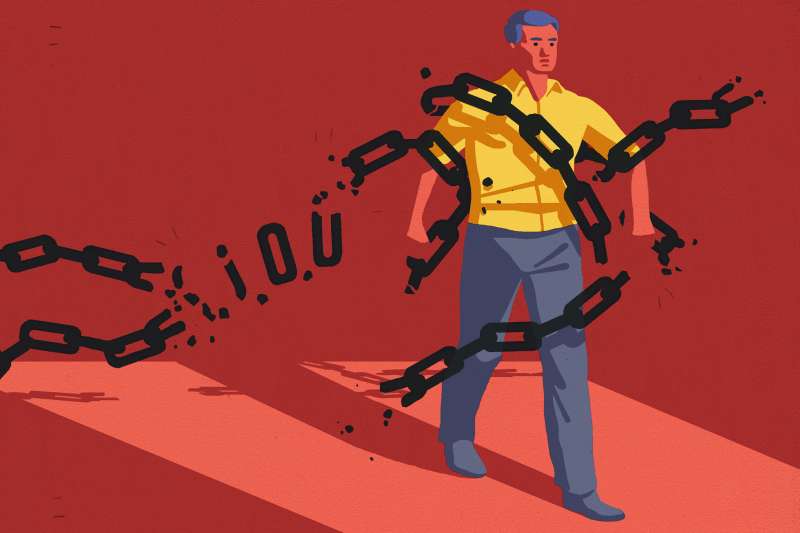How to Pay off Debt: 5 Expert-Approved Strategies That Work

While your debts shouldn’t define who you are, the money you owe plays a powerful role in shaping your personal finances. These contracts, and how you pay off your debt, influence the terms under which you can access credit in the future.
Any time you need to borrow money, whether to buy a house, finance a car, pay for medical procedures or advance your education, a lender is going to look at your debt-to-income ratio — how much you owe compared to how much you earn — along with your credit report, from which your credit score is drawn. The lower your credit score, the higher the interest rate you'll be charged on your loan.
Why paying off debt is so important
So if you want to raise your credit score, paying down obligations like credit card debt is the fastest way to do so. “Your debt plays a very primary role in the calculus of credit scoring,” says Galen Gondolfi, spokesman for Justine Petersen, a St. Louis-based financial education and assistance nonprofit.
While a track record of on-time payments is the biggest component of your FICO credit score (the most commonly used scoring model) at 35%, the balance of your debt to available credit — your credit utilization ratio, in financial advisor-speak — contributes another 30% to that score.
The best thing you can do for your credit score is to keep your utilization ratio as low as possible. “We encourage people to be under 30%, but the lower the better, of course,” Gondolfi says. For example, if your maximum available credit is, say, $10,000, try to keep your balance under $3,000.
There are different schools of thought for how to pay off debt: Even personal financial advisors know no single approach is right for everybody — and a combination of strategies might work best for you. Here are the best tips and tactics credit experts recommend to get you on the path to debt repayment.
Increase your monthly payments
The first step for how to pay off debt is to increase the amount of money you put into paying it down. It’s basic budgeting math: If you’re only making credit card minimum monthly payments, you’re barely chipping away at the principal. If you have to spend less money paying interest, debt gets paid down more quickly.
Even if you have good credit, experts say you’re playing with fire if you carry a high amount of debt. “We should be concerned about debt, regardless of the impact on that score,” Gondolfi says. Even if it hasn’t hurt your credit yet, that could change rapidly if you lose your job, especially if you’re one of the many people who don’t have a good-sized emergency fund in your bank account.
If you have both debt and a skimpy checking account balance, which should you prioritize first? Personal finance pros like credit counselors get this question often, and there’s no one right answer. If your household has more than one income stream, focusing on your debt is a good idea, because even if you lose your job, you’ll still be able to at least go back to making minimum monthly payments on your credit card balances.
If your family depends on a single income, your best bet is to divide and conquer: Set some money aside, even if it’s a small amount, and budget an equal amount towards the principal balance on your debts. Even if it takes you longer to become debt-free, it’s important to have an emergency fund so you’re not forced into taking on more high-interest credit card debt when unexpected expenses crop up. Federal Reserve data shows that the average annual percentage rate (APR) on an interest-accruing revolving credit account is just over 16%, and borrowers with checkered credit histories often pay much higher interest rates than that.
Use the ‘avalanche’ method
From a mathematical point of view, you can stretch your dollars the furthest — and get out of debt faster — if you target the outstanding balance with the highest interest rate. You might hear an advisor at a credit counseling agency or other personal finance assistance organization refer to this as the “avalanche method.”
“As a credit counseling agency, we typically recommend people tackle the debts with the highest interest rate first,” says Becky House, spokeswoman for American Financial Solutions, a Seattle-based credit and financial counseling organization. “As they pay accounts off, we recommend that they reallocate the payment from the paid in full account to the creditor with the highest interest rate. We know, logically, that it saves money,” she says.
If you have other types of non-mortgage debt — say, from a car loan, personal loan, student loans or medical bills — include them as well. The idea behind the “debt avalanche” is to eliminate those high-APR obligations as quickly as possible. Knocking out an outstanding balance on a credit card that carries a high interest rate frees up extra money that can accelerate your debt payoff goals.
Use the ‘snowball’ method
Another way to tackle credit card or other high-interest debt, using a tactic endorsed by personal finance guru Dave Ramsey, is the “snowball” method. Like the avalanche method, you strategically apply extra money to pay down your debts. The main difference is how you prioritize those payments.
The snowball method works like this: You funnel your extra funds to paying off your smallest debt first (just keep up with the minimum payments on the others, of course), then apply the money you would have spent each month servicing that debt to your next-highest credit card balance, and so on.
There is some compelling evidence that suggests the “snowball” method is successful from a psychological point of view, House says. “We all want results right now and it can be hard to keep momentum and enthusiasm when it feels like progress is slow,” she acknowledges. “So, assigning more money toward smaller accounts and seeing those paid in full more quickly can really motivate people,” she says.
While this is obviously not a quick fix if you have a lot of debt, snowball method adherents say that people are more likely to stay motivated when they see the smallest balance eliminated.
Transfer debt to a credit card
If you have a good credit score, one tactic that can speed up the debt repayment process is applying for a balance transfer credit card. Look for a 0% introductory APR period of at least 12 months. Since transfer fees can be as high as 5%, do some comparison shopping, particularly if you’re looking to transfer a large amount of money.
Calculate how much your debt payments need to be to bring your balance down to $0 before the promotional period ends. If you’re only making minimum payments, there’s a good chance you’ll still owe when the regular APR on your new balance transfer card kicks in.The disclaimer is that you should only follow this advice if you’re confident in your ability to control your spending and that you won’t run up credit card debt again after doing a balance transfer to a new card. “If you’ve got a card that now doesn’t have a balance, it can be awfully tempting to go back and use that empty card,” cautions Jeff Richardson, spokesman for VantageScore Solutions, a Stamford, Conn.-based company that supplies a credit-scoring formula used by the three major credit reporting bureaus.
Apply for a debt consolidation loan
If you don’t want to transfer your debt balances onto a credit card, or if you have debts like a car loan or student loans that will take years to pay off, Richardson says another debt repayment option is a debt consolidation loan.
This essentially is an unsecured personal loan, although some financial services providers do market loans specifically for debt consolidation. If you’re struggling to become debt-free because you’re saddled with high-APR credit card interest, this option can give you some breathing room. These loans generally come with fixed APRs which can be several percentage points lower than credit card interest rates.
Unlike revolving lines of credit, personal loans are installment loans, meaning they have fixed timetables. You can choose a repayment plan that fits your budget, since some issuers offer terms that can stretch for five years or longer. Of course, the longer the repayment period, the more interest you’ll pay over the life of the loan, so it’s in your best interest to look for the shortest term for which you can manage the monthly payment.
Installment loans also are viewed more favorably than revolving credit lines by conventional credit-scoring models, which means adding one could improve your credit profile (provided, of course, that you consistently make payments in a timely manner).
Finally, if you can’t or don’t want to open any new loan accounts or lines of credit, Richardson suggests calling up your credit card issuers and asking each for a lower interest rate. While there’s no guarantee they’ll say yes, it literally costs nothing to give it a shot. If you’re a borrower in good standing, they might knock a few percentage points off your APR, which will lower the cost of servicing your debt.
“It can’t hurt to ask for a lower interest rate,” Richardson says. “There’s no harm in that.”
More from Money:
7 Easy Ways to Improve Your Credit Score This Month
Best Balance Transfer Strategies to Pay Off Your Credit Card Debt in 2021
